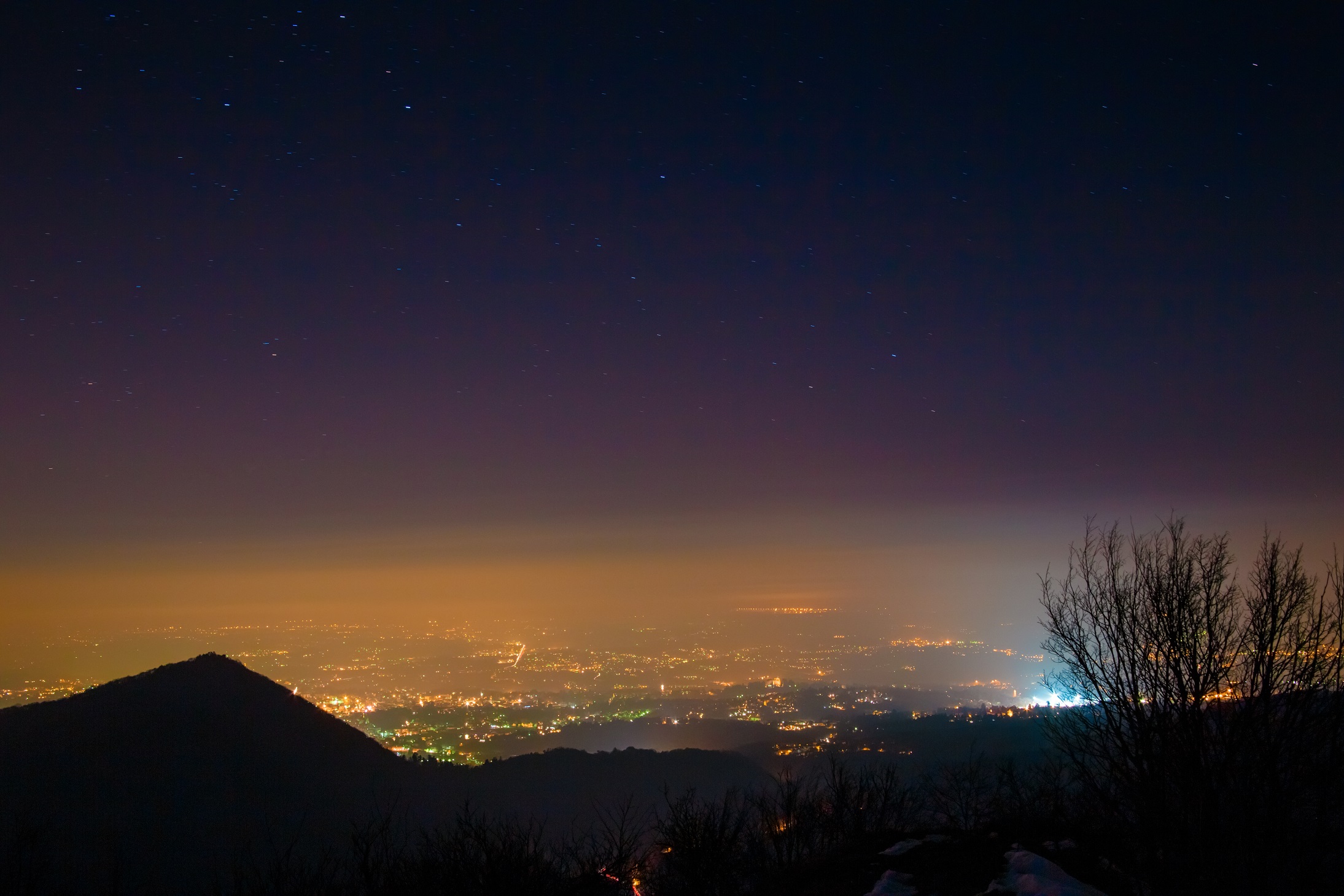Dark side of the light

“Two things fill the mind with ever new and increasing admiration and awe, the starry heaven above me and the moral law within me.” – Immanuel Kant wrote. Three centuries later, the first condition is becoming increasingly difficult to fulfil as a result of light pollution. Why do we see the stars less and less?
If you look at the earth from a bird’s eye view at night, you will not see darkness. There will be various clusters of lights. Skyglow over cities, red and white ribbons of roads, many smaller bright spots.
If, on the other hand, one looks at the night sky from the ground, it becomes increasingly difficult to see the stars in it. They have not disappeared, they are shining as before, but we are increasingly hampered in seeing them by the light emitted on the earth.
According to observations collected between 2011 and 2022 by the Globe at Night project, every year the sky gets 9.6 per cent brighter. Children born this year will see less than half as many stars on their 18th birthday as they do now. Already today, 30 percent of the world’s population and as many as 80 percent of US citizens cannot see the Milky Way. The increasing brightness of our planet is also confirmed by the data collected by satellites orbiting over it – which in turn shows that it increases by 2 percent every year.
This is why the problem of light pollution is becoming increasingly urgent. Because it is not only about the possibility of astronomical observations. It is about human health, the preservation of ecosystems, energy consumption.
Who can’t sleep
We need light to live. For millennia, man has only used two sources of it – the sun and fire. The gas lamp was first used in 1792, and in 1853 Ignacy Łukasiewicz developed the oil lamp. Mankind had to wait until 1879 for the light bulb to appear. But when it happened, the world lit up.
Artificial light extends our day and allows us to function even at night. It helps us to orientate ourselves and feel safer in space after dark. Illuminations serve us to decorate and to bring out what is beautiful (e.g. in architecture). It is just that we are increasingly finding that this has its dark side.
Light interferes with the production of melatonin, the hormone that regulates our diurnal rhythm and causes us to fall asleep. It is secreted after nightfall, gradually lowering blood pressure, glucose levels and body temperature. Melatonin increases our immunity, has antioxidant properties and lowers cholesterol levels. Its production is most inhibited by blue light emitted by LEDs or screens.
Scientists alert that exposure to light during sleep can negatively affect our metabolism and cause insulin resistance. A multi-year study by researchers at the Harvard T.H. Chan School of Public Health revealed that premenopausal women smoking cigarettes (even in the past) and living in better-lit areas had an increased risk of breast cancer. It was even higher in women working the night shift.
Lost turtles
Light pollution has a negative impact on many animal species, especially those that use moonlight to orient themselves in space or simply live a nocturnal lifestyle.
Sea turtles lay their eggs on beaches. The females do this at night, choosing dark places. And there are fewer and fewer of these, because if it’s a beach – it’s people, and if it’s people – it’s light. That’s why sometimes turtles have nowhere to lay their eggs. Young turtles, on the other hand, have to march from the beach to the sea, guided by the starlight and moonlight reflected in the water. The competing illumination causes them to lose their orientation, becoming prey for predators or dying of exhaustion. Their mothers also have a similar problem getting to the beach or back to the water.
The moon and stars are also used by many bird species to navigate. Artificial light disorientates them and can be a trap for them. They fall into a so-called ‘well of light’ from which they cannot get out (because they can’t see anything beyond it). The lamp is also a deadly danger for insects, not without reason it is said: they fly like moths to a flame.
Artificial light extends the day and therefore the activity time of predators. However, the so-called ‘ecological niche of night light’ does not benefit their prey and disturbs the ecosystem. There are animal species whose peak foraging time is during the new moon. When we artificially provide them with constant light, such as during a full moon, they lose the opportunity to satisfy their hunger.
These examples can be multiplied, as the diurnal rhythm of animals, established over millennia, has been disrupted by man and his artificial light.
Start diming
It is not a question of switching off the lighting, but of designing it wisely and adjusting its intensity according to demand. Streetlights do not need to illuminate the sky for us to feel safe at night. As calculated by the International Dark Sky Association (IDA), at least 35 percent of the light used outdoors is wasted in the United States. This is an unnecessary cost (equivalent to $3 billion per year) and consumption of electricity (resulting in 21 million tonnes of unnecessary carbon dioxide emissions).
Appropriate lighting can save up to 40 percent of energy costs. Appropriate, meaning what kind of lighting? Take, for example, a spherical street lamp. It directs as much as 60 percent of the light upwards and only 40 percent downwards. If we cover the upper half of the sphere, 80 percent of the light will fall downwards (20 percent will scatter to the sides). And if you remove the lower half of the sphere and leave a mushroom-shaped lamp, 100 percent of the light will be directed downwards. Such a lamp will provide the best illumination for the road or pavement, will not pollute the sky with light and will not dazzle people (or, for example, shine through a window into a house).
Shining from the top down, replacing the shade with a flat tempered glass (the shade diffuses the light), using motion sensors – these are the basic principles to follow when choosing outdoor lighting. Motion sensors can also be used on a wider scale, e.g. on pavements or cycle paths, where a stronger light accompanies the pedestrian or cyclist.
Half of the complaints and requests for intervention reported in the Dark Skies programme in Poland concerned the illumination of buildings. This is mostly done with halogen lamps placed in the ground, which, in addition to the building, illuminate the sky above it and its surroundings. A properly installed floodlight should have a shield to limit the light flux so that it is directed only at the building.
LED lighting is becoming increasingly popular – it uses less energy and is therefore cheaper and more environmentally friendly. The problem is that it has a high colour temperature, which means that it contains a lot of blue light in its spectrum. This is the light that inhibits the production of melatonin and brightens up the night sky the most. The International Dark Sky Association recommends that warm light with a colour temperature of no more than 3 000 Kelvin should be used outdoors.
Black sky at night
Could it be that star gazing and romantic walks in the moonlight are a thing of the past? After all, within the European Union we all have a more or less light-polluted sky above our heads (globally, only 8 percent of the population has a dark sky above their heads).
A sky free of artificial lights is becoming a value, which is why ‘darkness reserves’ are being set up in various parts of the world, operating in a similar way to nature reserves. The first was established in 1993 in the United States (Lake Hudson State Recreation Area’s Dark Sky Preserve).
There are two such places in Poland. The Izera Dark Sky Park has been in operation since 2009 and is located in Poland and the Czech Republic. It covers an area of 7,500 hectares, sparsely populated and sheltered from the lights of nearby towns by the mountains. At night, 800 stars can be counted here.
Definitely larger is the Bieszczady Starry Sky Park. Covering 113,800 hectares, it is the second largest such reserve in Europe. As we read on its website: “When you find yourself at night, in a place of wild, unspoilt nature, far from the lights of civilisation, you will see that we have lost touch with something fundamental. Something primal. We have forgotten what the night sky means to us, which is to remind us that there is something beyond our planet that transcends us. We have lost that magical component of life in our world, which is the starry sky, because there is no longer such a sky above us.”




